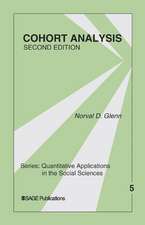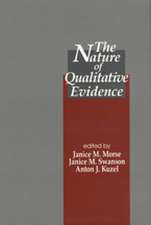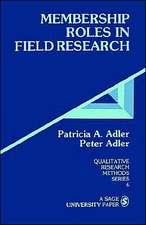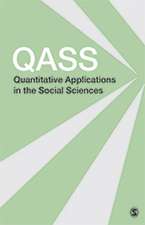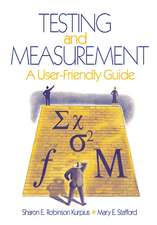Making Sense of Data in the Media
Autor Andrew Bell, Todd Hartman, Aneta Piekut, Alasdair Rae, Mark Tayloren Limba Engleză Paperback – 21 noi 2019
Through a series of examples of statistics in the media, this book shows you how to critically assess the presentation of data in the media, to identify what is significant and to sort verifiable conclusions from misleading claims. How accurate are polls, and how should we know? How should league tables be read? Are numbers presented as ‘large’ really as big as they may seem at first glance? By answering these questions and more, readers will learn a number of statistical concepts central to many undergraduate social science statistics courses. By tying them in to real life examples, the importance and relevance of these concepts comes to life. As such, this book does more than teaches techniques needed for a statistics course; it teaches you life skills that we need to use every single day.
| Toate formatele și edițiile | Preț | Express |
|---|---|---|
| Paperback (1) | 291.68 lei 3-5 săpt. | +33.15 lei 6-12 zile |
| SAGE Publications – 21 noi 2019 | 291.68 lei 3-5 săpt. | +33.15 lei 6-12 zile |
| Hardback (1) | 789.03 lei 6-8 săpt. | |
| SAGE Publications – 21 noi 2019 | 789.03 lei 6-8 săpt. |
Preț: 291.68 lei
Nou
Puncte Express: 438
Preț estimativ în valută:
55.81€ • 58.27$ • 46.19£
55.81€ • 58.27$ • 46.19£
Carte disponibilă
Livrare economică 14-28 martie
Livrare express 27 februarie-05 martie pentru 43.14 lei
Preluare comenzi: 021 569.72.76
Specificații
ISBN-13: 9781526447203
ISBN-10: 1526447207
Pagini: 272
Dimensiuni: 170 x 242 x 32 mm
Greutate: 0.73 kg
Ediția:1
Editura: SAGE Publications
Colecția Sage Publications Ltd
Locul publicării:London, United Kingdom
ISBN-10: 1526447207
Pagini: 272
Dimensiuni: 170 x 242 x 32 mm
Greutate: 0.73 kg
Ediția:1
Editura: SAGE Publications
Colecția Sage Publications Ltd
Locul publicării:London, United Kingdom
Recenzii
What a timely book. In a world drowning in data we all need to know how to critically evaluate the numbers we confront every day. This book will help you ask those all-important questions and demystify statistics. From ‘is that a lot?’ to ‘is that possible?’ the authors guide you through statistical techniques that are easy to understand and simple to apply. Read it, learn the techniques and use them to become a critical data consumer.
There are two ways to learn about statistics. You could endure pages of maths, formulae and words that are, literally, 'so last century' (or more). Or you could learn from informative case studies exploring how, when and why data are used well or badly in today's society. I prefer the second option; happily, the authors do too.
This excellent new book goes beyond the familiar fundamental concepts of statistics to cover the vital, but often neglected issues of place and time. It is essential reading for students who want to understand the use and misuse of numbers.
There are two ways to learn about statistics. You could endure pages of maths, formulae and words that are, literally, 'so last century' (or more). Or you could learn from informative case studies exploring how, when and why data are used well or badly in today's society. I prefer the second option; happily, the authors do too.
This excellent new book goes beyond the familiar fundamental concepts of statistics to cover the vital, but often neglected issues of place and time. It is essential reading for students who want to understand the use and misuse of numbers.
Cuprins
Chapter 1 Introduction
Chapter 2 How to make numbers sound big, or small, even when they aren’t: “Is that a lot?”
Chapter 3 Recognizing which numbers you should trust: “Where is the data from?”
Chapter 4 Making surveys representative: “Who you gonna call?”
Chapter 5 Graphics in the media and how to read them: “What does this mean?
Chapter 6 Maps in the media: “Where is this happening?"
Chapter 7 Mapping patterns and people: why does geography matter?
Chapter 8 Understanding uncertainty in estimation: “are you sure?”
Chapter 9 Ranking with league tables: “What's the best?"
Chapter 10 When a relationship (doesn’t) mean causality: “How did that happen?"
Chapter 11 Surprising quirks in the media: “Is that possible?"
Chapter 12 Conclusion
Chapter 2 How to make numbers sound big, or small, even when they aren’t: “Is that a lot?”
Chapter 3 Recognizing which numbers you should trust: “Where is the data from?”
Chapter 4 Making surveys representative: “Who you gonna call?”
Chapter 5 Graphics in the media and how to read them: “What does this mean?
Chapter 6 Maps in the media: “Where is this happening?"
Chapter 7 Mapping patterns and people: why does geography matter?
Chapter 8 Understanding uncertainty in estimation: “are you sure?”
Chapter 9 Ranking with league tables: “What's the best?"
Chapter 10 When a relationship (doesn’t) mean causality: “How did that happen?"
Chapter 11 Surprising quirks in the media: “Is that possible?"
Chapter 12 Conclusion
Notă biografică
Andrew Bell is a Lecturer at the Sheffield Methods Institute, University of Sheffield. His research spans a wide range of social sciences and beyond, with work on social inequalities, segregation, mental health, education and more. He also investigates the performance of different quantitative methods for use in the social sciences, with a focus on multilevel models. His twitter is @andrewjdbell.
Descriere
Through a series of examples of statistics in the media, this book shows you how to critically assess the presentation of data in the media, to identify what is significant and to sort verifiable conclusions from misleading claims.




